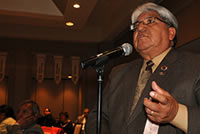Resolutions Search

What is an NCAI Resolution?
A resolution is one of the policy mechanisms utilized by NCAI to express the consensus positions of member tribes on tribal, federal, state, and/or local legislation, litigation, or policy matters that affect the welfare and rights of American Indian and Alaska Native governments or communities.
Only NCAI Individual Indian members in good standing are authorized to submit a resolution.
You can submit your resolution for the 80th Annual Convention & Marketplace now. Please use the 80th Annual Resolution Template to submit your resolution. Resolutions will only be accepted through this online form.
Membership and tribal delegate resolutions should be faxed or emailed to membership@ncai.org.
According to NCAI Standing Rules of Order, Section XIII, resolutions will not be considered at the Mid-Year Convention unless they are determined to be emergency in nature (issues that cannot wait until the Annual Session to be addressed) and national in scope.
All of NCAI’s advocacy work is guided by the resolutions process (PDF of NCAI's guidance document on how to submit a resolution). View a flowchart of NCAI's resolution process.
If you have issues submitting resolutions via the online form above, direct questions to Suzanne Gould.
NCAI members establish the organization’s positions on issues that affect tribal nations and Native people through a resolutions process. NCAI resolutions are one of the policy mechanisms used to express the organizational positions on tribal, federal, state, and/or local legislation, litigation, and policy matters that affect tribal governments or communities.
The resolutions created and passed by NCAI members cover a broad range of topics and are important for providing direction to the organization and as advocacy tools with policy makers. Currently, the online searchable database houses nearly 1,000 resolutions dating back to 2001. The organization's online archives will continue to expand and reach as far back as 1944.